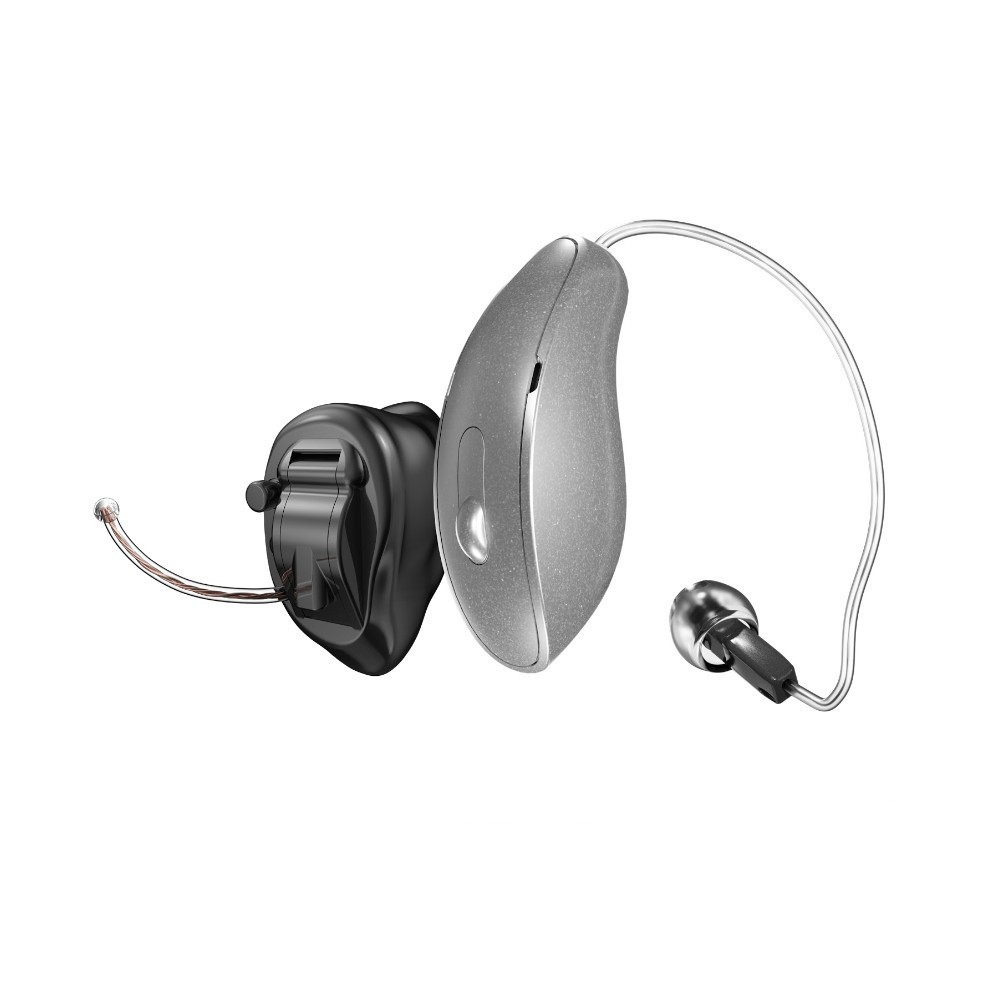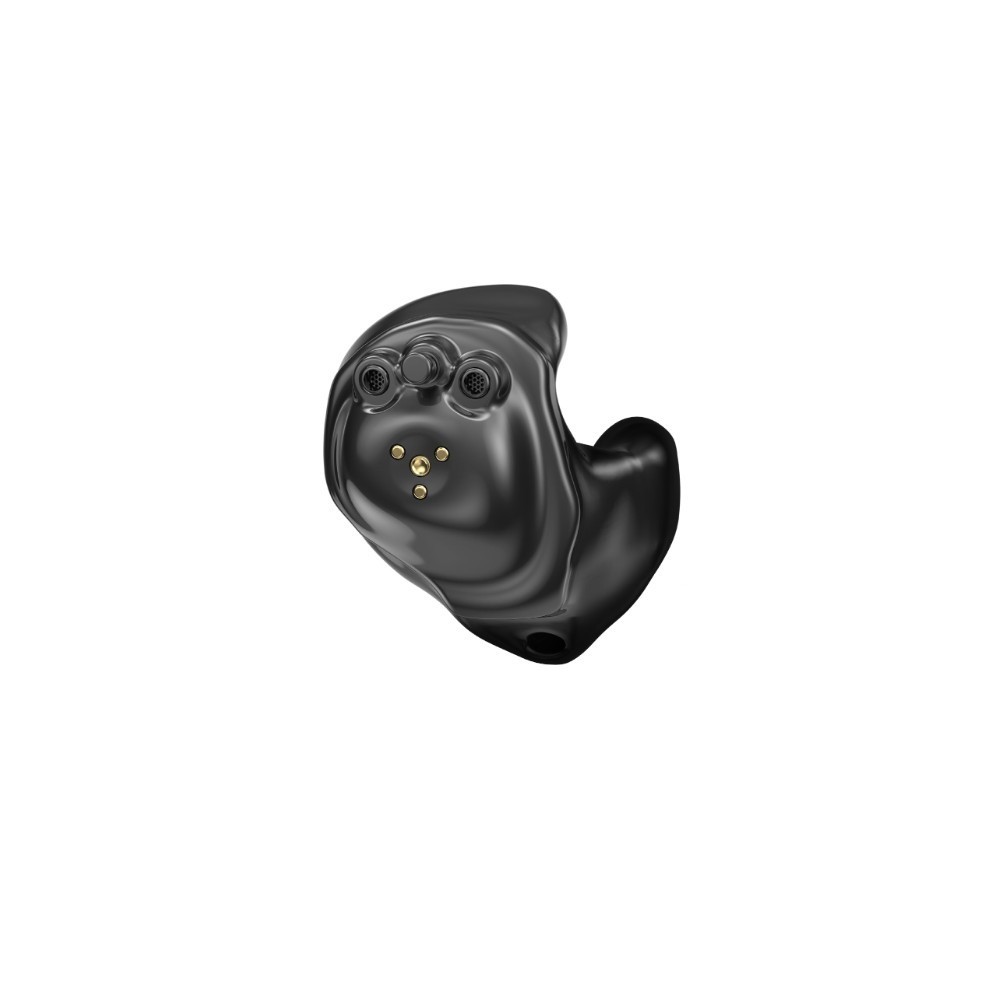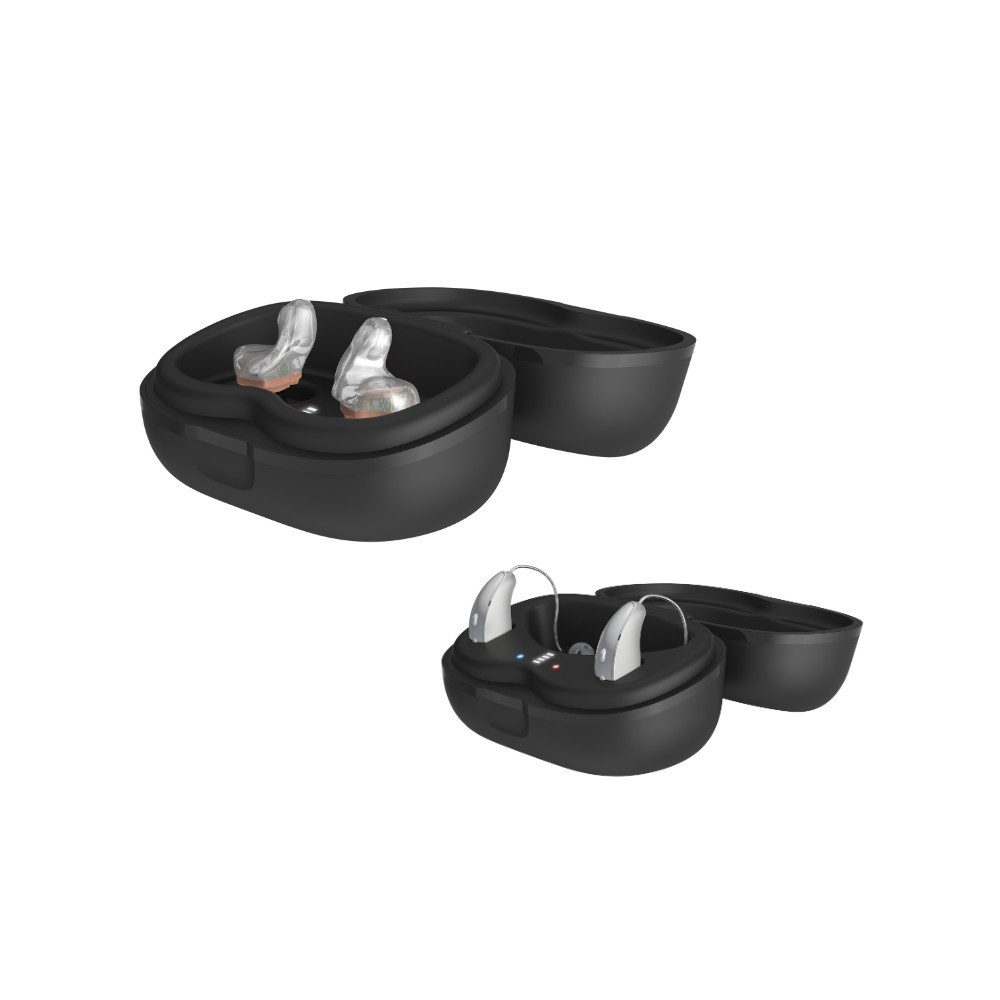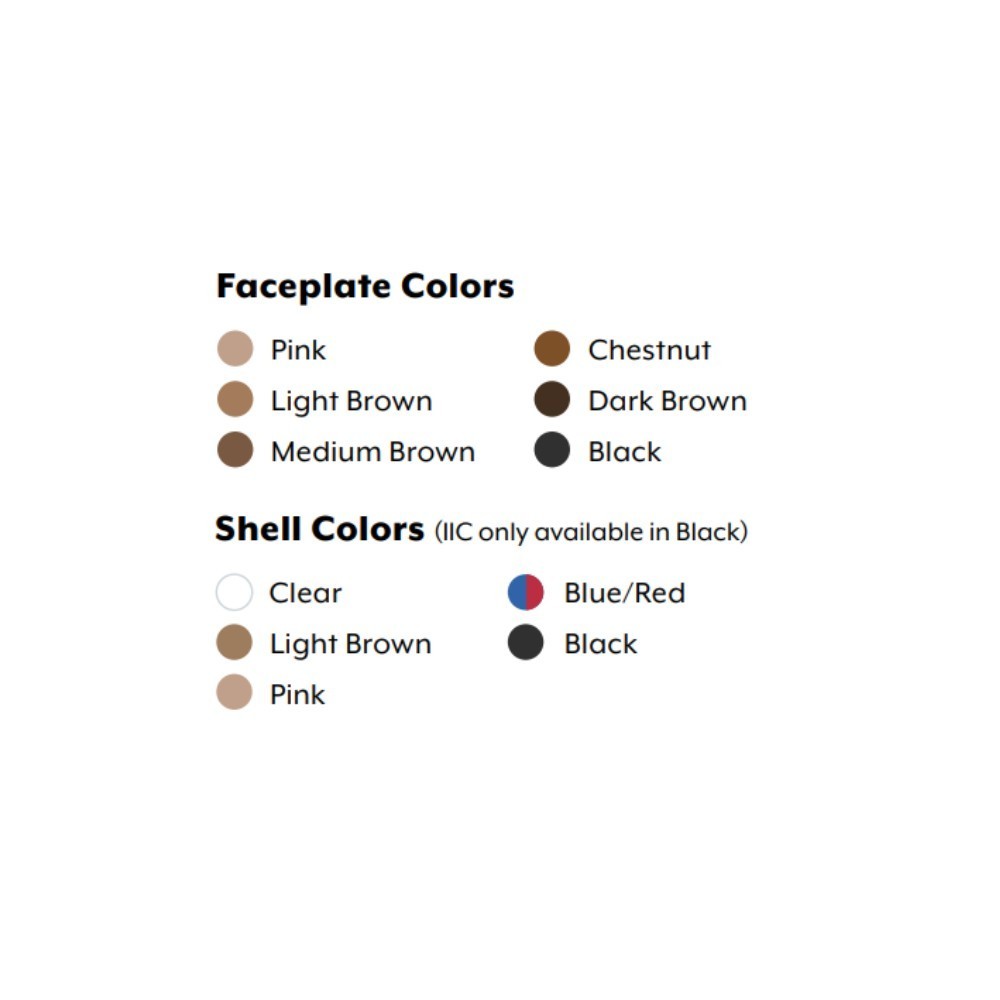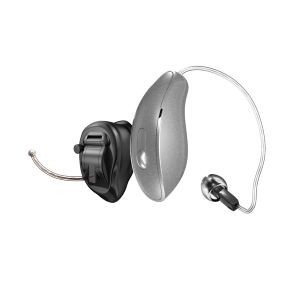Fitting Styles: RIC, ITE, ITC, CIC
Warranty: 5 years
Charger: Rechargeable an additional £100 per aid

What's included in our hearing aid prices?
Details & Features
Overview of Starkey Edge AI 20 hearing aids
The Starkey Edge AI 20 hearing aids are designed to aid those with hearing loss by stimulating the brain’s auditory cortex and enhancing speech clarity while minimising background noise, all thanks to their innovative AI capabilities.
Featuring a sleek, discreet design, the Edge AI 20 aids offers one of the longest-lasting rechargeable batteries in the industry to date, providing up to 51 hours of listening on a single charge. They are also available in six styles, including rechargeable options, and offer solutions for different levels of hearing loss.
Other features include seamless Bluetooth connectivity, the My Starkey app for easy management, and compatibility with accessories like the StarkLink Edge TV Streamer, enhancing the overall user experience and convenience.
Starkey Edge AI stimulates the brain's auditory cortex
Listening is a complex process that generally comes easily to those with "normal" hearing but can be difficult for those with hearing loss. Starkey Edge AI 20 uses new technology, the G2 Neuro Processor, to stimulate the brain’s auditory cortex, helping to navigate these challenges. This is achieved through real-time classification of complex sound environments, enhancement of speech clarity, and reduction of background noise, all powered by Edge's advanced AI.
But what does this really mean for your hearing? It means you'll enjoy a more natural listening experience. Coupled with Neuro Sound Technology 2.0, which mimics the brain's natural processes, you’ll gain greater control and management of your sound environment.
This technology operates across three key domains: Sensory, which analyses your surroundings; Subconscious, which manages tasks automatically in the background; and Conscious, which provides users with enhanced control and flexibility over their hearing experience.
The Edge AI 20 hearing aids offer a modern, sleek design that is both discreet and comfortable, making them nearly invisible to others. These aids are also water-resistant, sweatproof, and designed for everyday use, ensuring durability in life's various conditions.
How does artificial intelligence help your hearing?
AI makes these devices smarter and more personalised. For example, with AI technology, hearing aids can automatically adapt to different environments, seamlessly switching from a noisy restaurant mode to a quieter conversation mode. This allows users to enjoy clearer sound without the hassle of adjusting settings manually.
Moreover, AI learns from individual preferences over time, tailoring the listening experience to fit unique habits and needs. It’s like having a helpful assistant who ensures you hear better in different situations.
How long does the battery last?
The battery life of Starkey Edge AI hearing aids varies by model and usage. The rechargeable Edge AI RIC RT model provides up to 51 hours on a single charge, even when using advanced features like the G2 Neuro Processor and LE Audio streaming. Other rechargeable models, like the mRIC R and custom ITE/ITC, generally offer between 33 and 42 hours per charge, depending on user settings.
For models with disposable batteries, the RIC version with a size 312 battery can last up to 6 days without streaming, while the CIC model can last up to 8 days.
What's the difference between Starkey Edge AI and Genesis AI?
A key difference between Starkey Edge AI and Genesis AI hearing aids is their technology. Edge AI features the advanced G2 Neuro Processor, offering 100 times more processing power than Genesis AI, resulting in enhanced sound processing, improved speech recognition, and superior noise reduction.
Edge AI also includes Bluetooth Low-Energy (LE) connectivity, a Smart Audio Assistant, and an upgraded automatic Edge Mode+. While both models provide excellent hearing solutions, Edge AI stands out with its modern, AI-driven features. Therefore, there would be no reason to opt for the older model, Genesis AI.
What is Edge Mode+?
Once activated, Edge Mode+ automatically adjusts to changes in your environment through the My Starkey app. This AI-driven feature offers on-demand noise management and speech clarity adjustments, making it particularly useful in challenging listening situations like crowded restaurants, travelling by car, or watching TV at home.
Hearing aid models and colours available
Starkey Edge AI 20 hearing aids are available in six styles, including rechargeable Receiver-in-Canal (RIC) models, size 312 disposable battery options, as well as rechargeable In-the-Ear (ITE) and In-the-Canal (ITC) models. There’s also a Completely-in-Canal (CIC) version that uses a size 312 battery.
The RIC models are available in a variety of colours, including Chestnut, Tech Black, Graphite Grey, Silver, White, Caramel, and Beige. For custom shells, you can choose from Clear, Pink, Light Brown, Blue/Red, and Black, while the custom faceplates are offered in Light Brown, Medium Brown, Chestnut, Dark Brown, and Black.
These devices are offered in three technology tiers (24, 20, and 16) and accommodate different levels of hearing loss from mild to severe. Two models, the RIC RT and RIC 312, are compatible with CROS technology for those with single-sided deafness. Model breakdown:
- Starkey Edge AI 20 CIC hearing aids: Completely-in-Canal (CIC) model with Bluetooth and traditional battery.
- Starkey Edge AI 20 ITC R hearing aids: Rechargeable, water-resistant In-the-Canal (ITC) model with Bluetooth.
- Starkey Edge AI 20 ITE R hearing aids: Rechargeable, water-resistant In-the-Ear (ITE) model with Bluetooth.
- Starkey Edge AI 20 RIC 312 hearing aids: Receiver-in-Canal (RIC) model with Bluetooth, traditional battery, and CROS compatibility.
- Starkey Edge AI 20 RIC R T hearing aids: Rechargeable, water-resistant Receiver-in-Canal (RIC) model with Bluetooth, CROS compatibility, and telecoil.
- Starkey Edge AI 20 mRIC R hearing aids: Small, rechargeable Receiver-in-Canal (RIC) model with Bluetooth.
My Starkey App, Bluetooth connectivity, and accessories
The My Starkey app, designed with user feedback, is compatible with both Edge AI and Genesis AI hearing aids to enhance listening experiences and simplify daily life. It's also compatible with the new Apple Watch, allowing users to adjust settings, stream calls, and find lost hearing aids.
The app tracks wellness goals by counting steps and measuring engagement. Other features include language translation, reminder settings, and other tools to improve daily convenience.
Starkey Edge AI 20 introduces the StarkLink Edge TV Streamer, which is future-proof and Auracast-ready, using Bluetooth Low Energy (LE) Audio to deliver high-quality audio from your TV directly to compatible hearing aids. Other compatible accessories include:
- TV Streamers: Stream audio directly from your TV or other electronic devices.
- Table Microphones: Ideal for group settings, these microphones transmit the primary speaker’s voice straight to your hearing aids.
- Mini Remote Microphones: Perfect for clear, one-on-one conversations in noisy environments.
- Remote Controls: The StarLink Remote Control 2.0 allows easy volume adjustments and program switching.
- Chargers: StarLink Premium/standard Charger 2.0 for RICs and Custom Charger 2.0 for rechargeable ITE models.
What features do you lose when comparing the 20 with the 24?
Starkey Edge AI 20 hearing aids offer seamless Bluetooth connectivity, enabling users to easily connect to smartphones, tablets, TVs, and audio equipment. This enhances control and convenience:
- Receive calls directly with your hearing aids.
- Enjoy TV at your preferred volume with wireless accessories.
- Stream music directly from devices.
- Manage hearing aids and track health through the My Starkey app.
With these features and accessories, Starkey Edge AI 20 hearing aids provide great solutions to enhance the hearing experience. The Bluetooth LE Audio protocol enhances connectivity while using less power, enabling faster pairing and more reliable streaming. It's universally compatible with Apple iOS and the latest Android devices, ensuring you're ready for future Auracast broadcasts.
When comparing Starkey Edge AI 20 with the 24, what's missing in terms of features? In short, you'll miss out on some automation and user controls, plus there is no Voice AI feature at this performance level.
Other performance levels in the range:
►Starkey Edge AI 24 hearing aids
►Starkey Edge AI 16 hearing aids
Want to know more about Starkey Edge AI 20?
Call us free on 0800 567 7621 to chat about these Starkey digital hearing aids, what they can do for your hearing loss, and whether they are the right hearing aids for you.
Please note that there will be an additional surcharge of £125 if we are pairing a single hearing aid with an existing aid bought from another company, where we are taking over the aftercare responsibilities and looking after both hearing aids.
Starkey Edge AI 20 Hearing Aids Information
Click on the buttons below to discover moreWatch the Starkey Edge AI Hearing Aid Video Below
Need more support?
Here, at Hearing Aid UK, we offer a wide range of hearing aids available on the market - keeping up to date with the best and latest hearing aid technology.
We can support your hearing healthcare in clinic or in the comfort of your own home and with nationwide coverage, we will have an audiologist near you. Whatever your hearing loss level, budget, or style our audiologists can help you find the perfect hearing solution for you.
Call us free for support and advice on 0800 567 7621
Our specialist service includes:
Do not spend hundreds of pounds without getting a second opinion from us.
Please call us on 0800 567 7621
 Not only are the prices great, but the service is fantastic! Many thanks to your team.
Not only are the prices great, but the service is fantastic! Many thanks to your team.Other pages you might find useful
What's included in our hearing aid prices?
If you are looking at this page then it is likely that an audiologist has suggested that you purchase this particular hearing aid, so is this the best model for you?
In general, any audiologist will always recommend to you the model that best suits your needs. Here is a useful checklist to make sure that is the case.
- Audiologist level of knowledge: The audiologist you have seen will hopefully have a wide knowledge of all available hearing aids, however, some will only be familiar with a small number of brands and therefore may not really be in a position to know which model is the best for you. It is OK to challenge their recommendation and ask them to justify why this particular brand is the one for you.
- Do research: Read about the hearing aid that was recommended. Does it seem like it will suit your lifestyle? Does it have more or fewer features than you need?
- Be aware of sales targets: Many high street retailers have specific tie-ins to a particular manufacturer/brand. The hearing aid they have suggested may still be the correct one for you, but do your research so that you know why they might have recommended it.
If in doubt, feel free to give us a call. That's what we're here for. In the meantime, read all about our review of the best hearing aids for 2025 here
If you have significant hearing loss in both ears, you should be wearing two hearing aids. Here are the audiological reasons why:
Localisation: The brain decodes information from both ears and compares and contrasts them. By analysing the minuscule time delays as well as the difference in the loudness of each sound reaching the ears, the person is able to accurately locate a sound source. Simply put, if you have better hearing on one side than the other, you can't accurately tell what direction sounds are coming from.
Less amplification is required: A phenomenon known as “binaural summation” means that the hearing aids can be set at a lower and more natural volume setting than if you wore only one hearing aid.
Head shadow effect: High frequencies, the part of your hearing that gives clarity and meaning to speech sounds, cannot bend around your head. Only low frequencies can. Therefore if someone is talking on your unaided side you are likely to hear that they are speaking, but be unable to tell what they have said.
Noise reduction: The brain has its own built-in noise reduction which is only really effective when it is receiving information from both ears. If only one ear is aided, even with the best hearing aid in the world, it will be difficult for you to hear in background noise as your brain is trying to retain all of the sounds (including background noise) rather than filtering it out.
Sound quality: We are designed to hear in stereo. Only hearing from one side sounds a lot less natural to us.
Fancy some further reading on this topic? You can read about why two hearing aids are better than one in our article, hearing aids for both ears, here
For most people, the main benefit of a rechargeable hearing aid is simple convenience. We are used to plugging in our phones and other devices overnight for them to charge up. Here are some other pros and cons:
For anybody with poor dexterity or issues with their fingers, having a rechargeable aid makes a huge difference as normal hearing aid batteries are quite small and some people find them fiddly to change.
One downside is that if you forget to charge your hearing aid, then it is a problem that can't be instantly fixed. For most a 30-minute charge will get you at least two or three hours of hearing, but if you are the type of person who is likely to forget to plug them in regularly then you're probably better off with standard batteries.
Rechargeable aids are also a little bit bigger and are only available in Behind the Ear models.
Finally, just like with a mobile phone, the amount of charge you get on day one is not going to be the same as you get a few years down the line. Be sure to ask what the policy is with the manufacturer warranty when it comes to replacing the battery.
Looking for more information on rechargeable hearing aids? Read our dedicated page on the topic here
For most people, the answer is yes. But it's never that simple.
The majority of hearing problems affect the high frequencies a lot more than the low ones. Therefore open fitting hearing aids sound a lot more natural and ones that block your ears up can make your own voice sound like you are talking with your head in a bucket. Therefore in-ear aids tend to be less natural.
However the true answer is we can't tell until we have had a look in your ears to assess the size of your ear canal, and until we have tested your hearing to see which frequencies are being affected.
People with wider ear canals tend to have more flexibility, also there are open fitting modular CIC hearing aids now that do not block your ears.
There is also the age old rule to consider, that a hearing aid will not help you if it's sat in the drawer gathering dust. If the only hearing aid you would be happy wearing is one that people can't see, then that's what you should get.
Most people can adapt to any type of hearing aid, as long as they know what to expect. Have an honest conversation with your audiologist as to what your needs are.
Generally speaking, six or more. Unless it's none at all.
The number of channels a hearing aid has is often a simplistic way an audiologist will use to explain why one hearing aid is better than another, but channels are complex and it is really not that straightforward. Here are some reasons why:
Hearing aids amplify sounds of different frequencies by different amounts. Most people have lost more high frequencies than low and therefore need more amplification in the high frequencies. The range of sounds you hear are split into frequency bands or channels and the hearing aids are set to provide the right amount of hearing at each frequency level.
Less than six channels and this cannot be done with much accuracy, so six is the magic number. However, a six channel aid is typically very basic with few other features and is suitable only for hearing a single speaker in a quiet room. The number of channels is not what you should be looking at, it's more the rest of the technology that comes with them.
As a final note, different manufacturers have different approaches. One method is not necessarily better than any other. For example, some manufacturers have as many as 64 channels in their top aids. Most tend to have between 17 and 20. One manufacturer has no channels at all.
Hearing aids are easily lost, misplaced or damaged and typically are one of the most expensive personal possessions an individual can own. We offer hearing aid warranty coverage for £80 per year per aid. Find out more about this service we provide here
Other Models
Ask the Experts
6 Morton Lane
Walkwood
Redditch
Worcestershire
B97 5QA
Latest Launch
When we refer to a product as 'Latest Launch', we mean it is the latest to be released on the market.
New
When we refer to a product as 'New', we mean that the product is the newest hearing aid model on the market.
When we refer to a product as 'Superseded', we mean that there is a newer range available which replaces and improves on this product.
Older Model
When we refer to a product as an 'Older Model', we mean that it is has been superseded by at least two more recent hearing aid ranges.


